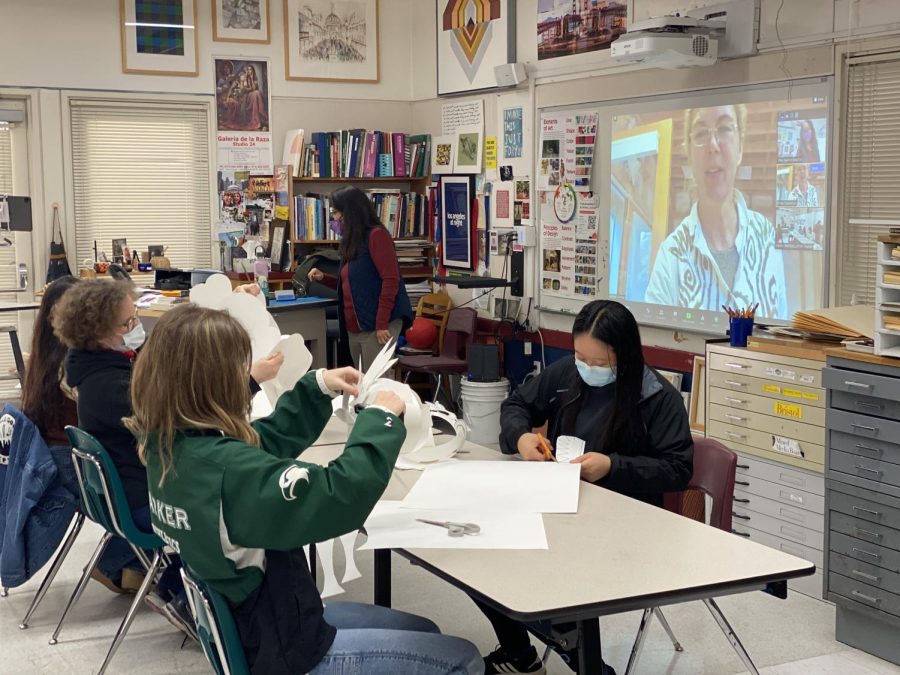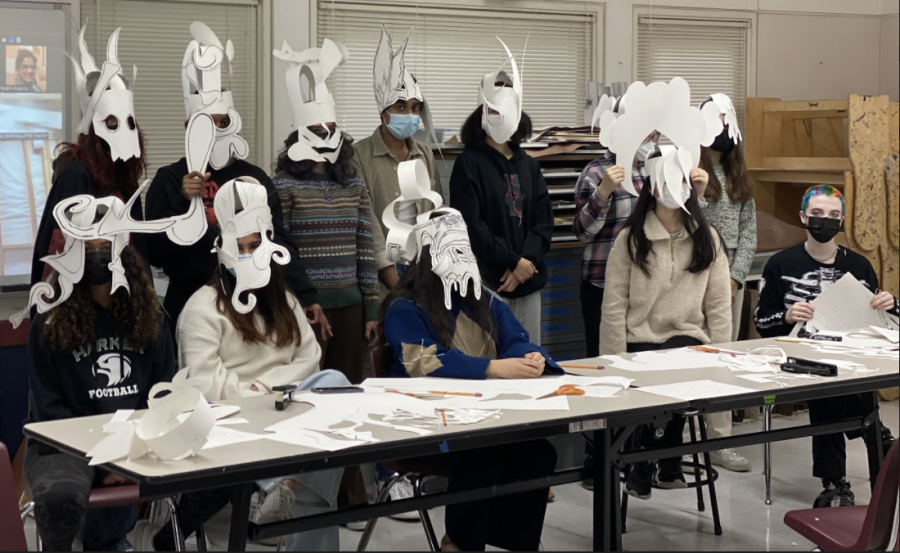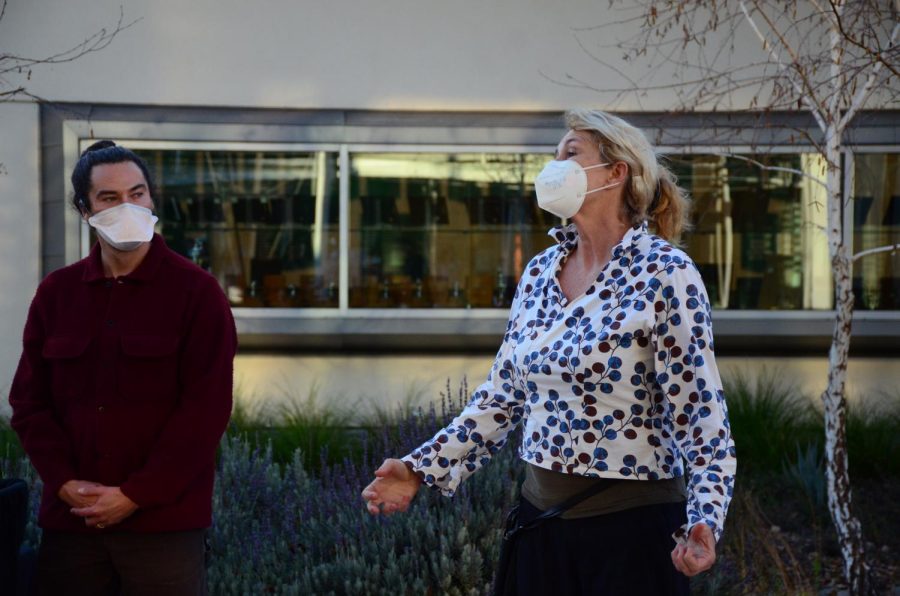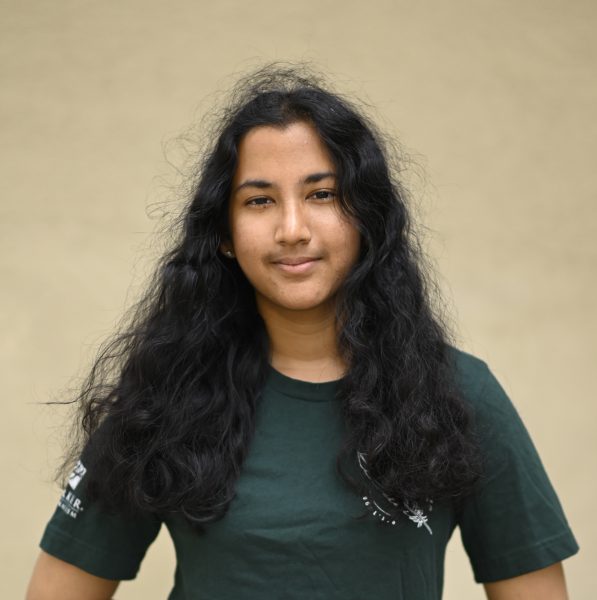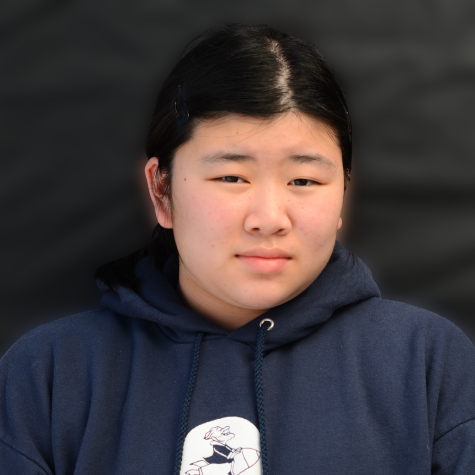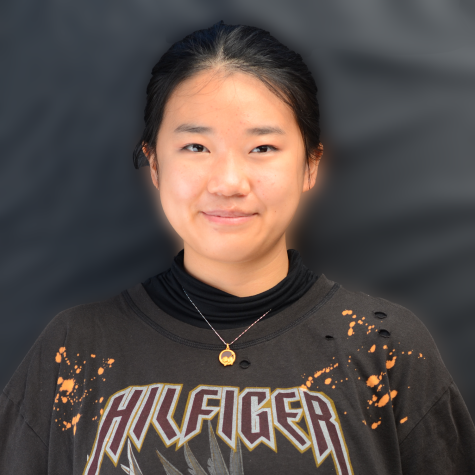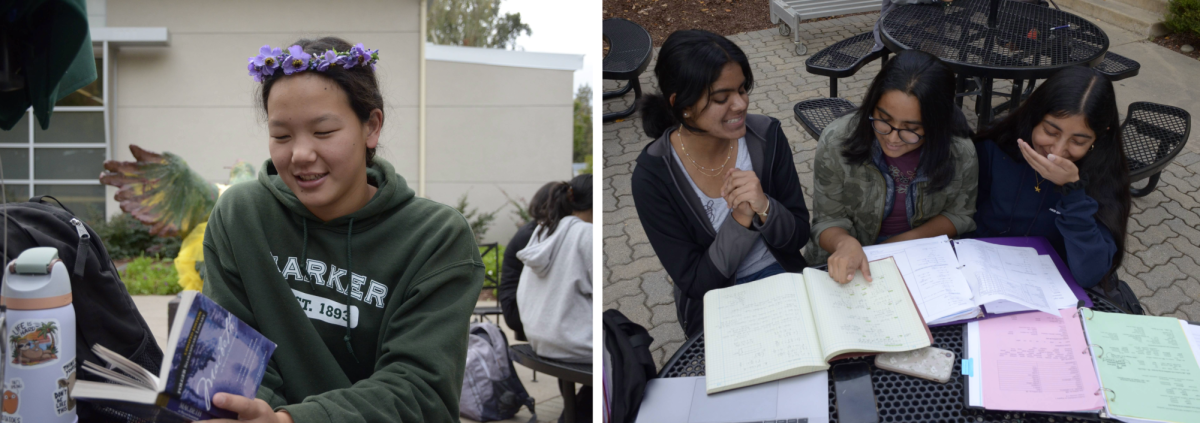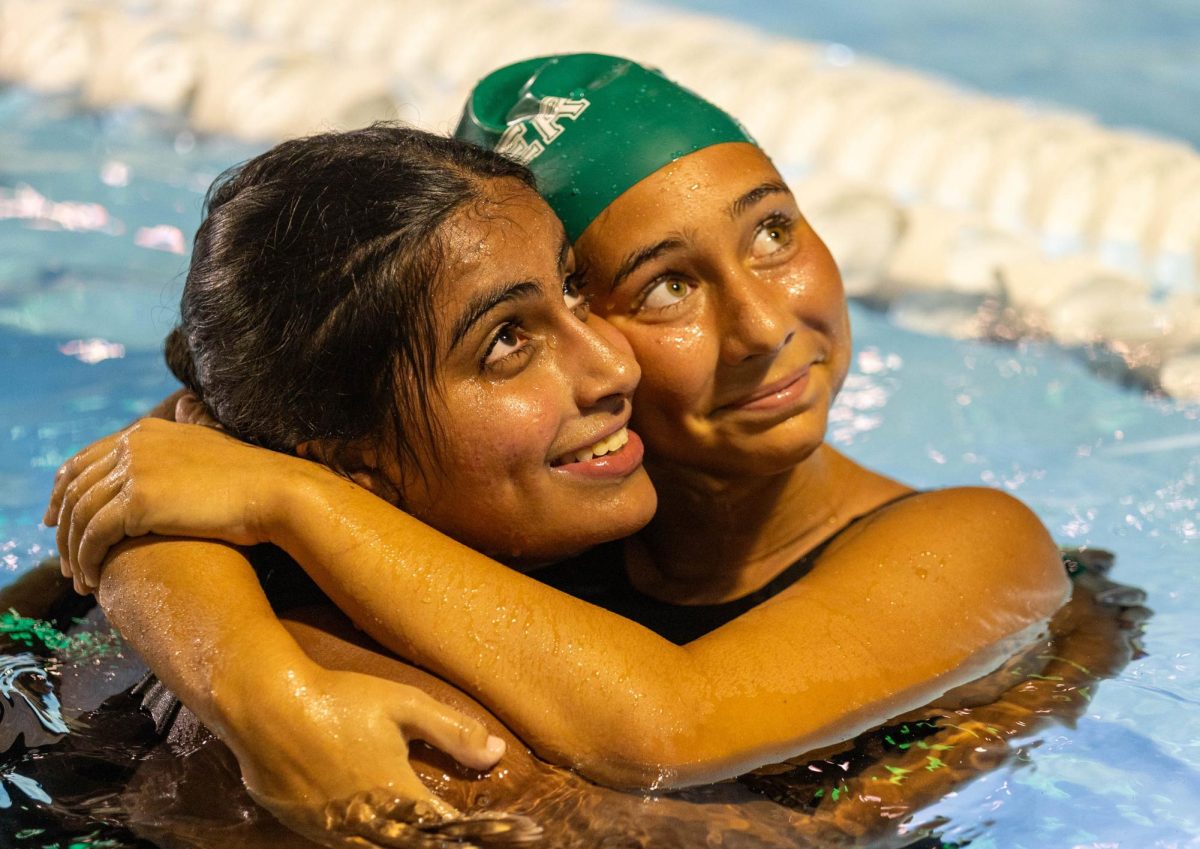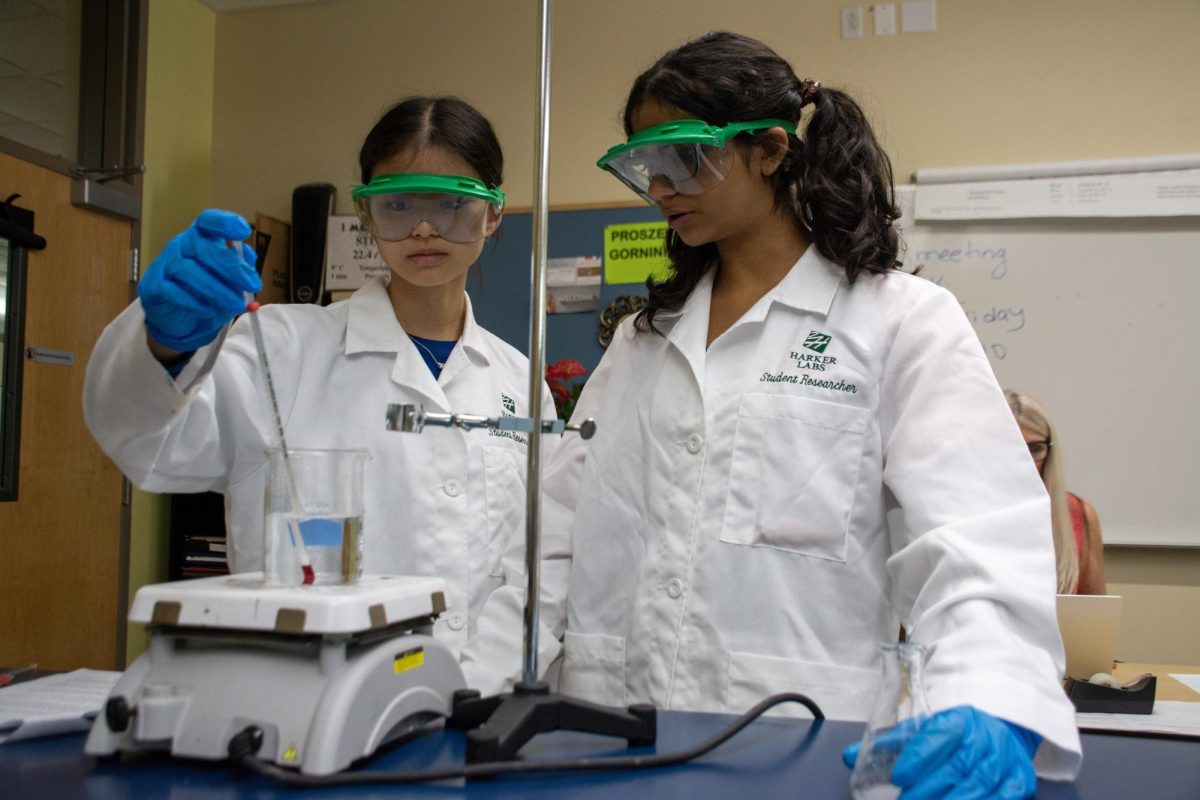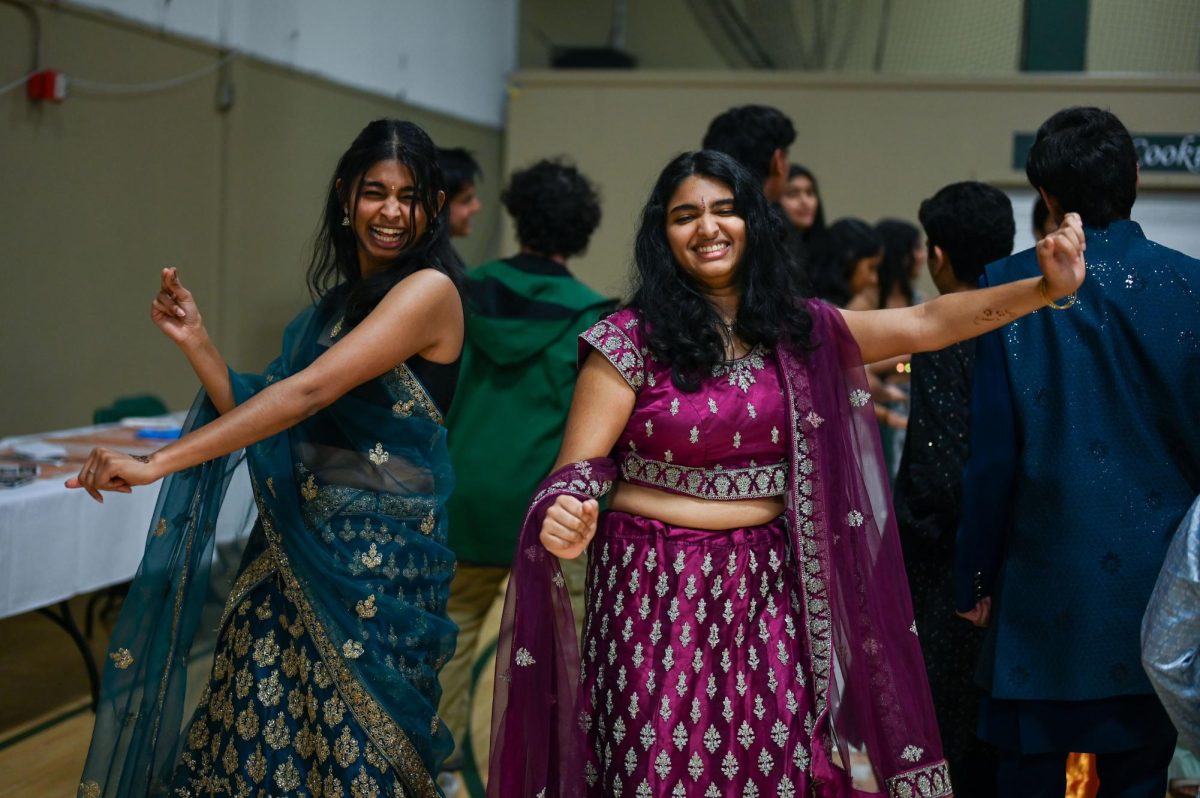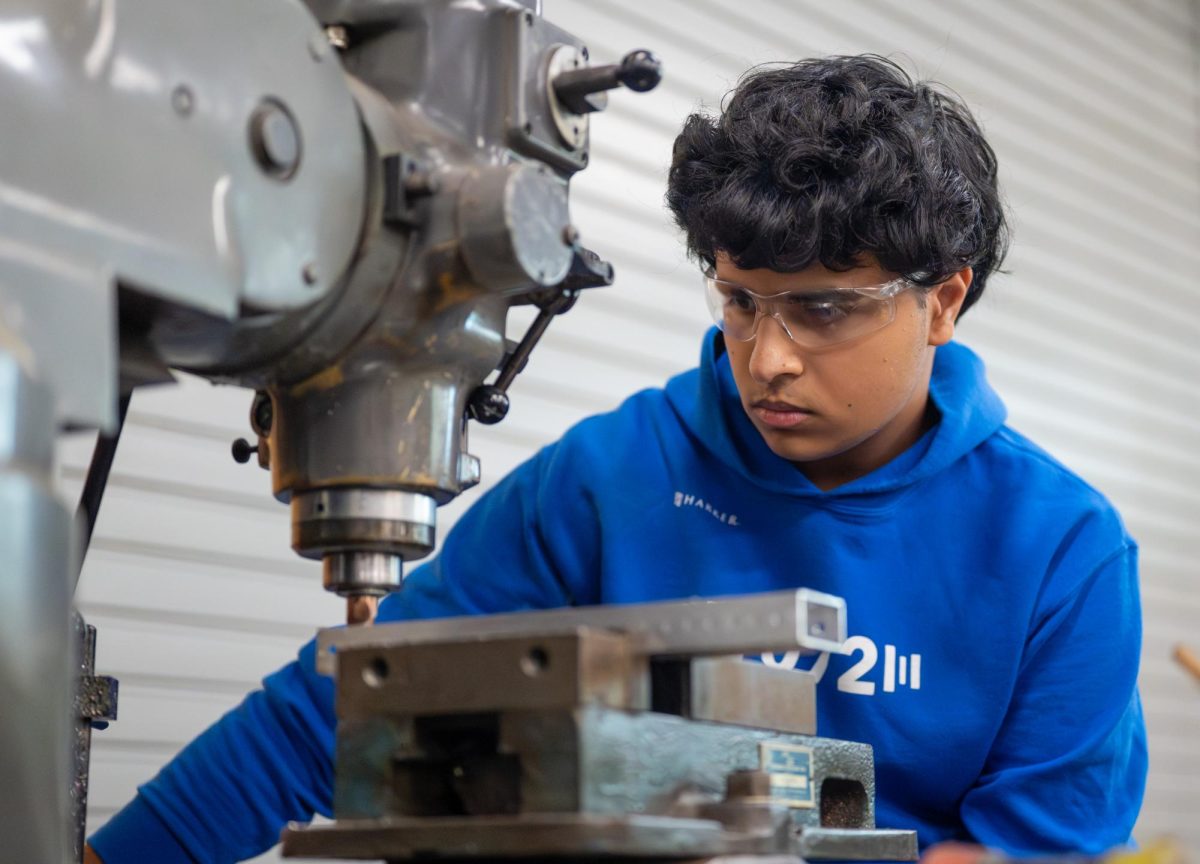Upper school launches new visual arts endowment with first artist-in-residence
Upper school’s first artist-in-residence Britta Clausnitzer advises students via Zoom on the Jan. 11 art workshop. Students had the opportunity to create painted paper masks at two workshops held by Art Club which they wore during the “Tiger on the Loose” performance on Jan. 19.
February 6, 2022
Wearing brightly-colored decorative masks fashioned out of paper shapes, a cohort of students strides out of the art building. As they make their way across campus, stopping occasionally to pose for pictures as a group, upbeat music floats through the air from a small speaker held by the upper school’s first artist-in-residence, Britta Clausnitzer, whose works are currently displayed in the Rothschild Performing Arts Center (RPAC) to kick off the newly-created Dickinson Visual Arts Endowment.
Director of the Office of Communication Pam Dickinson established the Dickinson Visual Arts Endowment, announced by the school on Dec. 9, to support the visual arts department. Students who attended the two art workshops held on Jan. 7 and Jan. 11 in the art room as part of the endowment’s launch had the opportunity to create painted paper masks with the guidance of Clausnitzer, who offered them advice via Zoom. On Jan. 19, students participated in a performance called “Tiger on the Loose” in which they donned their masks and walked from the art room to the Nichols auditorium, where Clausnitzer gave a talk about her artwork and creative process.
“I think it’s great to have someone come from outside of Harker to talk with us about her own experience,” sophomore Sania Gupta, who attended the workshops, said. “And [I liked] seeing her art and how her ideas are incorporated in her own art and what she’s teaching us.”
During the workshops, Clausnitzer encouraged students to create art with intention, advice that senior Arkita Jain, who also attended the workshops, appreciated. After initially sketching 10 shapes, Arkita realized a preference for a wavy, organic shape and focused on cutting out that same type of shape afterwards.
“I really liked how Britta told us to channel our energy,” Arkita said. “So when I was drawing my initial 10 pieces, I was really thinking about myself, and I asked people what they thought represented me.”
After the “Tiger on the Loose” performance, the students settled into their seats as the lights dimmed and a painting was projected onto the screen. Titled “Pack,” the artwork depicts multiple wolves seemingly bursting from a central figure, a woman, surrounded by a riot of colors.
Britta asked the audience their impressions of the painting and divulged some of the inspirations behind it, such as humanity’s relationship with nature. She also talked about using “collective imagery,” connections to events or objects that people make when looking at a certain image, such as the “Renaissance pose,” exemplified by certain sculptures from that period.
“So if we have two big blocks in a painting, what will everybody think?” Clausnitzer said during her talk. “You know, we have two large, square blocks — then we have 9/11. When we have a woman standing with a dress, over some air coming up, what’s that? Collective imagery. Marilyn Monroe.”
She then displayed three other paintings, some of which are available to view in the “Tigerfeast” exhibit of her works in the RPAC, and similarly explained the inspirations behind them, which ranged from horror movies to Théodore Géricault’s oil painting “The Raft of the Medusa.” To conclude her talk, she played a compilation video of herself creating paintings live.
“I go all over the canvas, and patches and patterns appear,” Clausnitzer said. “Some come from my imagination, but a lot of imagination is always a pool of things I see, and a lot of what I see comes from nature. The separation of human life from nature is always a theme for me, and trying to merge figures and creatures with nature, but juxtaposed by very surreal elements.”
Selina Chen (10), who attended the workshops and participated in the “Tiger on the Loose” performance, considers the artist-in-residency program a fun and interactive way to educate students about art, especially because of the possibility of bringing in artists with a variety of backgrounds and styles.
“Even if they aren’t pursuing a career in art, everybody could learn a lot from programs like this, whether it’s the stories that inspired the works of art or the style or medium,” Selina said. “I think there’s a lot of potential in learning new things about art.”
After Clausnitzer’s talk, the upper school held a public reception launching her residency from 4 to 5:30 p.m. outside the RPAC on Jan. 19. Visitors milled about tall tables draped in black tablecloth and viewed paper booklets with Clausnitzer’s work as they enjoyed food and beverages. Clausnitzer was also there in-person to converse with the visitors.
Art Club officer Gloria Zhu (12) appreciated seeing the paintings displayed in the “Tigerfeast” exhibit in the RPAC and learning about how Clausnitzer incorporated performance elements into her artwork, something Gloria had previously had no experience in. She also enjoyed learning about Clausnitzer’s artistic process.
“She really makes heavy use of layers, spontaneous brushstrokes, and allusions to various other types of various other pieces of media and her artwork, and I think it was really inspiring to see a successful artist’s process,” Gloria said.
Aside from the references to mainstream culture and art history that appear in her work, a characteristic feature of Clausnitzer’s pieces are what she calls a “certain atmosphere,” a timeless, ambiguous setting for the characters in her paintings that makes it impossible for the viewer to pinpoint their location to somewhere specific. Her works emphasize lines and layers and play with the idea of different interpretations of nature and aspects that attendees of her Jan. 19 talk described as “strange” and “otherworldly.”
“[The painting “Pack”] is also about the artificiality of our perception, how it is transposed,” Clausnitzer said. “We see nature all the time, we see leaves and everything and we take a photo of something we like, and already it is transferred into something else. So a lot of my paintings go about these layers. Layers of reality, layers of vision, layers of impressions.”
Students and faculty can view the “Tigerfeast” exhibit displaying Clausnitzer’s works in the downstairs RPAC until April 29.


















![“[Building nerf blasters] became this outlet of creativity for me that hasn't been matched by anything else. The process [of] making a build complete to your desire is such a painstakingly difficult process, but I've had to learn from [the skills needed from] soldering to proper painting. There's so many different options for everything, if you think about it, it exists. The best part is [that] if it doesn't exist, you can build it yourself," Ishaan Parate said.](https://harkeraquila.com/wp-content/uploads/2022/08/DSC_8149-900x604.jpg)




![“When I came into high school, I was ready to be a follower. But DECA was a game changer for me. It helped me overcome my fear of public speaking, and it's played such a major role in who I've become today. To be able to successfully lead a chapter of 150 students, an officer team and be one of the upperclassmen I once really admired is something I'm [really] proud of,” Anvitha Tummala ('21) said.](https://harkeraquila.com/wp-content/uploads/2021/07/Screen-Shot-2021-07-25-at-9.50.05-AM-900x594.png)







![“I think getting up in the morning and having a sense of purpose [is exciting]. I think without a certain amount of drive, life is kind of obsolete and mundane, and I think having that every single day is what makes each day unique and kind of makes life exciting,” Neymika Jain (12) said.](https://harkeraquila.com/wp-content/uploads/2017/06/Screen-Shot-2017-06-03-at-4.54.16-PM.png)








![“My slogan is ‘slow feet, don’t eat, and I’m hungry.’ You need to run fast to get where you are–you aren't going to get those championships if you aren't fast,” Angel Cervantes (12) said. “I want to do well in school on my tests and in track and win championships for my team. I live by that, [and] I can do that anywhere: in the classroom or on the field.”](https://harkeraquila.com/wp-content/uploads/2018/06/DSC5146-900x601.jpg)
![“[Volleyball has] taught me how to fall correctly, and another thing it taught is that you don’t have to be the best at something to be good at it. If you just hit the ball in a smart way, then it still scores points and you’re good at it. You could be a background player and still make a much bigger impact on the team than you would think,” Anya Gert (’20) said.](https://harkeraquila.com/wp-content/uploads/2020/06/AnnaGert_JinTuan_HoHPhotoEdited-600x900.jpeg)

![“I'm not nearly there yet, but [my confidence has] definitely been getting better since I was pretty shy and timid coming into Harker my freshman year. I know that there's a lot of people that are really confident in what they do, and I really admire them. Everyone's so driven and that has really pushed me to kind of try to find my own place in high school and be more confident,” Alyssa Huang (’20) said.](https://harkeraquila.com/wp-content/uploads/2020/06/AlyssaHuang_EmilyChen_HoHPhoto-900x749.jpeg)



